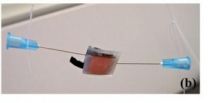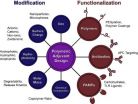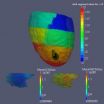Adults' tonsillectomy complications are higher than previously thought
2014-04-03
(Press-News.org) Twenty percent of adults who have tonsillectomies will have a complication, which is significantly higher than previously shown, according to a team of researchers. The team also found that these complications substantially increase health care expenditures.
"Since 1973, John Wenneberg and his colleagues at Dartmouth have been examining variation in the rates of tonsillectomy performed across regions, trying to explain why such wide variation is observed," said Dennis Scanlon, professor of health policy and administration, Penn State. "In other words, why are some patients significantly more likely to get the procedure in some areas of the country compared to others? Yet despite the wide degree of regional variation reported, most of which has been documented in pediatric populations, much less is known about the safety and risks to patients who undergo the procedure, particularly adult patients."
According to Scanlon, the team's study is the first of its kind to examine a large adult population, across institutions and provider practices and over multiple years using the Truven Health MarketScan Database. Previous studies focused on small numbers of patients within particular institutions and have not considered a wider spectrum of complications beyond post-tonsillectomy hemorrhage.
To conduct its study, the team, which also included researchers from the Kaiser San Francisco Medical Center and Truven Health Analytics, examined data from 36,210 adult tonsillectomy patients. The results will appear in the April 2014 issue of Otolaryngology -- Head and Neck Surgery.
The findings suggest that of adult patients who have undergone a tonsillectomy, 20 percent had a complication, 10 percent visited an emergency room, and approximately 1.5 percent were admitted to a hospital within 14 days of the procedure. Six percent of adult patients were treated for postoperative hemorrhage; 2 percent were treated for dehydration; and 11 percent were treated for ear, nose or throat pain within 14 days of surgery.
"These estimated complication rates are significantly higher than those reported in prior studies," Scanlon said.
The researchers also investigated expenditures associated with adult tonsillectomies and found that, on average, the amount paid for a tonsillectomy without complication was $3,832 whereas tonsillectomy with hemorrhage resulted in an average expenditure of $6,388.
"Our results highlight the challenges patients face when making informed decisions about medical and surgical treatments, as well as the excess costs and harm incurred due to complications," Scanlon said. "Patients expect to compare the risks and benefits of treatment options, but as our study shows, credible patient-centered information is often lacking, even for a common procedure that has been in practice for many, many years. The availability of important risk and benefit information should be expedited, and providers need to be trained to engage patients in how to use this information to make informed choices." INFORMATION:
Other authors on the paper include Meena Seshamani of formerly of Kaiser San Francisco Medical Center and Emily Vogtmann, Justin Gatwood and Teresa B. Gibson of Truven Health Analytics.
ELSE PRESS RELEASES FROM THIS DATE:
Report documents cardiopulmonary arrest in premature infant after cyclomydril eyedrops
2014-04-03
San Francisco, CA, April 2, 2014 – Eyedrops administered to infants as part of routine outpatient retinopathy of prematurity (ROP) screening can have life-threatening consequences. A case report published in the current issue of the Journal of the American Association for Pediatric Ophthalmology and Strabismus (AAPOS) describes cardiopulmonary arrest in a 27-week-old infant following administration of three sets of cyclopentolate 0.2%/phenylephrine 1% (Cyclomydril) eyedrops.
"Cardiopulmonary arrest can occur from just instillation of eyedrops in a premature infant seen ...
Drawing conclusions
2014-04-03
Is a picture worth only a thousand words? According to Dr. Carmit Katz of Tel Aviv University's Bob Shapell School of Social Work, illustrations by children can be a critical tool in forensic investigations of child abuse.
Dr. Katz's study, published in Child Abuse and Neglect, compared the results when child abuse victims were offered the opportunity to draw during questioning with victims not offered this opportunity. Her findings saw a significant difference, suggesting a therapeutic value and indicating that children empowered to draw pictures about their abuse provided ...
Radium-223 dichloride in prostate cancer: Major added benefit for certain patients
2014-04-03
Radium-223 dichloride (radium-223 for short, trade name: Xofigo) has been approved since November 2013 for men with advanced prostate cancer, in whom hormone blockade is no longer effective, and symptomatic bone metastases, but without visceral metastases. In an early benefit assessment pursuant to the Act on the Reform of the Market for Medicinal Products (AMNOG), the German Institute for Quality and Efficiency in Health Care (IQWiG) examined whether this new drug offers an added benefit over the appropriate comparator therapy specified by the Federal Joint Committee (G-BA).
No ...
Nanoparticles cause cancer cells to self-destruct
2014-04-03
Using magnetically controlled nanoparticles to force tumour cells to 'self-destruct' sounds like science fiction, but could be a future part of cancer treatment, according to research from Lund University in Sweden.
Watch video:https://www.youtube.com/watch?v=vos0QW2Yclk&feature=youtu.be
"The clever thing about the technique is that we can target selected cells without harming surrounding tissue. There are many ways to kill cells, but this method is contained and remote-controlled", said Professor Erik Renström.
The point of the new technique is that it is much more ...
Tiny power generator runs on spit
2014-04-03
Saliva-powered micro-sized microbial fuel cells can produce minute amounts of energy sufficient to run on-chip applications, according to an international team of engineers.
Bruce E. Logan, Evan Pugh Professor and Kappe Professor of Environmental Engineering, Penn State, credited the idea to fellow researcher Justine E. Mink. "The idea was Justine's because she was thinking about sensors for such things as glucose monitoring for diabetics and she wondered if a mini microbial fuel cell could be used," Logan said. "There is a lot of organic stuff in saliva."
Microbial ...
Attracting wild bees to farms is a good insurance policy
2014-04-03
EAST LANSING, Mich. -- Investing in habitat that attracts and supports wild bees in farms is not only an effective approach to helping enhance crop pollination, but it can also pay for itself in four years or less, according to Michigan State University research.
The paper, published in the current issue of the Journal of Applied Ecology, gives farmers of pollination-dependent crops tangible results to convert marginal acreage to fields of wildflowers, said Rufus Isaacs, MSU entomologist and co-author of the paper.
"Other studies have demonstrated that creating flowering ...
Pulmonary hypertension deaths have increased over past decade according to CDC report in CHEST
2014-04-03
Deaths from pulmonary hypertension have increased over the past decade, according to a study from the Centers for Disease Control and Prevention (CDC).
In the study, published online in CHEST, researchers analyzed death rates from the National Vital Statistics System and data from the National Hospital Discharge Survey between 2001 and 2010 to analyze trends in hospitalizations and death rates related to pulmonary hypertension.
Pulmonary hypertension is characterized by increased blood pressure in the pulmonary arteries, causing the right side of the heart to work ...
Tiny biomolecular tweezers studying force effect of cells
2014-04-03
A new type of biomolecular tweezers could help researchers study how mechanical forces affect the biochemical activity of cells and proteins. The devices — too small to see without a microscope — use opposing magnetic and electrophoretic forces to precisely stretch the cells and molecules, holding them in position so that the activity of receptors and other biochemical activity can be studied. Arrays of the tweezers could be combined to study multiple molecules and cells simultaneously, providing a high throughput capability for assessing the effects of mechanical forces ...
Enhancing the immune response through next generation polymeric vaccine adjuvants
2014-04-03
The great success of vaccines over the past two centuries as a preventive medicine has led to a significant reduction in morbidity and death caused by controllable infectious diseases. The effectiveness of vaccines is dependent on their ability to induce a protective immune response in recipients. Adjuvants, such as aluminum salts, have been integrated into vaccines for more than 70 years to augment the body's immune response to patho-gens. Adjuvants are especially necessary to boost the immune response for subunit vac-cines. However, conventional adjuvants are limited ...
Diffeomorphometry and geodesic positioning systems for human anatomy
2014-04-03
A team of researchers from the Center for Imaging Science at the Johns Hopkins University and the CMLA of the École Normale Supérieure Cachan have demonstrated new algorithmic technologies for the parametric representation of human shape and form. Coupled with advanced imaging technologies, this presents opportunities for tracking soft-tissue deformations associated with cardiovascular studies, radiation treatment planning in Oncology, and neurodegenerative brain illnesses. The software algorithms provide tools for basic science and pre-clinical investigations for synchronizing ...




